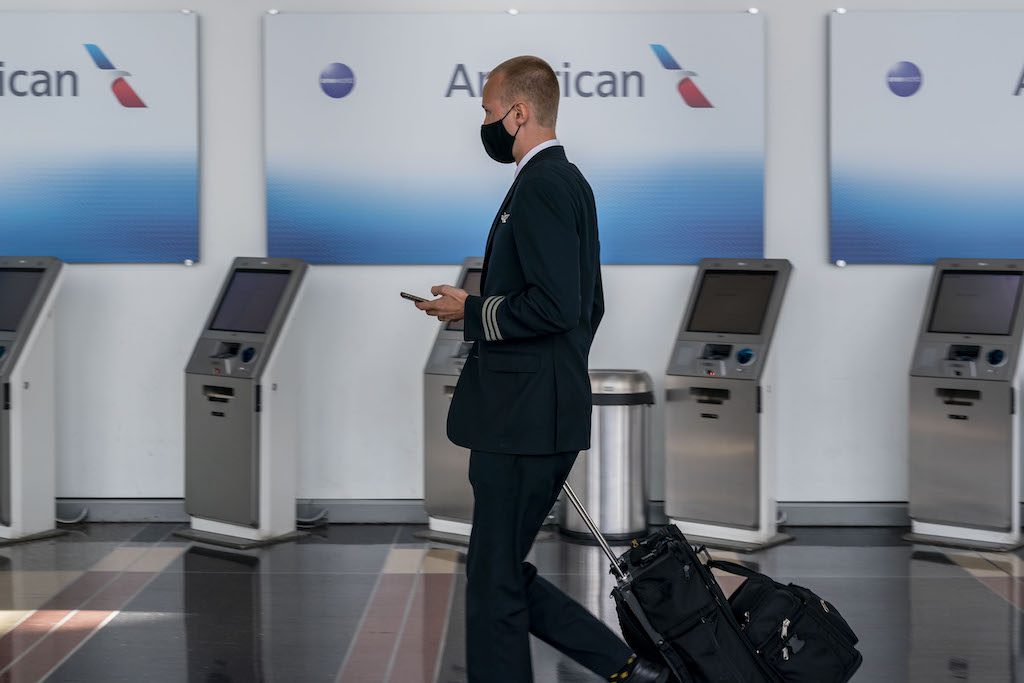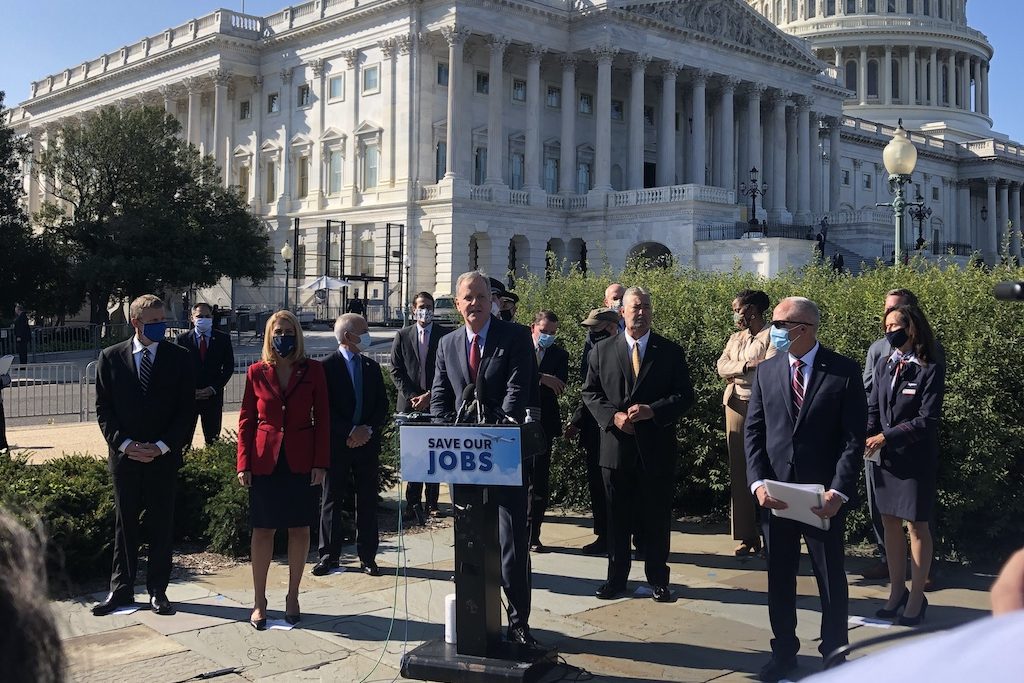Federal Aid Saved U.S. Airlines From the Worst of the Pandemic But Was It a Success?

Skift Take
The aviation industry was one of the single largest beneficiaries from the U.S. government’s $4.5 trillion in Covid-19 pandemic relief. Airlines received $74 billion from three measures, including the Trump administration’s CARES Act to the Biden administration’s American Rescue Plan, to shore up their balance sheets but, mostly, to keep staff on their rosters.
On the surface, the relief did what it needed to do. No major airline shut down or filed for Chapter 11 bankruptcy restructuring, though several small carriers — including Compass Airlines, RavnAir and Trans States Airlines — closed their doors. And the number of people employed by the industry stood at 709,544 at the end of May, down just 6 percent from the month before the pandemic set in, February 2020, according to U.S. Bureau of Transportation Statistics data. Nearly all of those departures were voluntary.
“I think it's an overwhelming success,” American Airlines CEO Doug Parker said when asked about the federal relief earlier in July. He cited his own carrier’s nearly 45 percent capacity growth from the first quarter to the second quarter in line with the snapback in leisure travel as an example of something made possible with the payroll support relief.
And that growth was not limited to American. Industrywide, U.S. domestic capacity jumped an impressive 35 percent from the first to second quarters, according to Cirium schedules. And compared to two years ago, it was only down 19 percent in the June quarter.
The U.S. airline recovery has made the industry as something of a poster child — at least among global airlines — of a successful aid program. Industry executives in Europe and elsewhere repeatedly look to the country as an example of how government support can allow for a rapid recovery.
In fact, industry trade group the International Air Transport Association (IATA) forecasts that the U.S. will be one of just three domestic markets globally — the others being China and Russia — where passenger numbers recover to pre-pandemic levels this year. While that recovery is in no small part driven by vaccinations and traveler confidence, the organization has repeatedly made it clear that without government relief there would have been a much deeper industry restructuring and likely bankruptcies.
Priming For Recovery
Last September, the heads of American, JetBlue Airways and United Airlines, along with union leaders and Congressional representatives stumped for more aid on the lawn of the U.S. Capitol. At the time the industry was staring down a cliff on October 1 — dubbed “terrible Thursday” by Cowen Analyst Helane Becker — when CARES Act employee protections would expire and tens-of-thousands of airline staff faced involuntary furloughs. Parker, along with JetBlue CEO Robin Hayes and United CEO Scott Kirby, made the case that allocating more funds would not only allow them to retain staff but also enable the industry to resume flights much faster than if they downsized.

“What this does is give us all a chance to keep critical infrastructure in place,” said Kirby referring to air service as “critical infrastructure” at the September event. “If you stop service to a city, it’s harder to get back in.”
The same goes for airline employees. Once a pilot, flight attendant or other skilled staff member leaves a carrier, they must repeat training and certification before they can fly again. That process can take several weeks or even months in certain cases for pilots. Other customer-facing staff, especially at airports, also need to go through a time consuming security badging process before they can return to work.
Airlines eventually got the money they sought but not after more than 30,000 people were involuntarily furloughed. American, United and others called back staff after Congress passed the first payroll support extension in December. That two-month gap is behind some of the ramp up bumps travelers have experienced this spring and summer.
American pared its schedule by 1 percent in June and July in the face of a pilot training backlog and severe weather. Several other carriers, including Alaska Airlines and Delta, have had to ask management staff to help out at airports, particularly in entry-level jobs. And other airport service providers that did not receive government aid, notably the Transportation Security Administration and concessionaires — like shops and restaurants — have faced significant challenges meeting hiring goals and opening in time for the summer surge.
“Now, to turn the faucet full on has really [created] some stresses and strains ... but if [payroll support] hadn’t been around, it would have been disastrous,” said Captain Joe DePete, president of the Air Line Pilots Association (ALPA) that represents crews at more than 20 airlines.
Complaints, Still
If there is one thing that people like, it is to complain about airlines. Whether it is about tepid coffee or a delayed bag, everyone has a story. And the federal aid for the industry is no different.
“It’s incredible to say no to someone about a refund when that same taxpayer is funding your survival,” Kurt Ebenhoch, executive director of Travel Fairness Now, told CNBC on Wednesday. He joined other air travel consumer groups in airing their grievances with Transportation Secretary Pete Buttigieg that day.
Ebenhoch’s issue is not a new one. Starved for cash early on in the pandemic, many airlines automatically issued vouchers to travelers rather than refunds for cancelled tickets, a move that roiled passenger advocates. Other issues raised at the meeting included airlines’ numerous extra fees, for example for assigned seats, and cramped aircraft layouts. Though both of latter complaints were points of contention prior to the crisis as well.
The CARES Act, and subsequent payroll support extensions, came with strings attached but not related to any passenger-facing concern. Airlines were barred from paying dividends or buying back shares, as well as giving bonuses to senior executives. In addition, they were required to maintain air service to all of their pre-pandemic U.S. destinations save a few exemptions.
Other critiques of the program are broader. While airlines were hit hard, many service industries across the U.S. were hit even harder. A recent analysis by the Federal Reserve found that roughly 200,000 businesses closed during the first year of the pandemic — March 2020 to February 2021 — on top of the normal rate of closure. Personal care service businesses, like barber shops or nail salons, were hit hardest yet neither were given targeted relief.
The CARES Act and subsequent relief bills did provide broad aid to small businesses. The paycheck protection program allowed some companies to keep staff on the payroll but it lacked the industry-specific protection airlines received. For example, the hotel industry shed tens-of-millions of jobs — something that has hampered its recovery this summer — even with the availability of paycheck protection. In June, the hospitality and leisure sector was still 2.2 million jobs short of February 2020 levels.
Asked how the airline industry was so successful in securing aid, Association of Flight Attendants-CWA (AFA) President Sara Nelson was blunt in her response: unionization.
“Organize [your] industry so that you have the same kind of union density that we have in the airline industry,” was her response to workers in other industries keen to replicate the airline industry’s success. After the initial CARES Act, unions led the push to extend the payroll support program beyond September, eventually gaining the backing of the airlines themselves and Congressional leaders.
In 2020, nearly 70 percent of workers at the country’s four largest airlines — American, Delta, Southwest Airlines and United — were represented by unions, individual carrier data shows. Comparatively, only 6.5 percent of workers in the accommodation industry were organized, according to the U.S. Bureau of Labor Statistics.
Was $74 Billion Enough?
Few expect airlines or their unions to return to Capitol Hill with their hands outstretched for a fourth tranche of aid. Many carriers, including Delta, Southwest and United, anticipate turning a profit in the second half of the year excluding the remaining payroll support funds that will give them a boost through September 30. And both the president and Congressional leaders have turned their attention to passing Biden’s signature infrastructure plan with the focus on a bipartisan deal in the Senate.
However, neither DePete nor Nelson would go so far as to say airlines would not need more aid. Both union leaders said the industry needed to stay vigilant amid the emergence of new Covid-19 variants, and that vaccination campaigns needed to continue — both in the U.S. and abroad.
“It’s a bit early to tell,” said DePete, who added that he is “monitoring literally everything.”
U.S. carriers have expressed little concern for the Covid-19 Delta variant that is spreading rapidly. During recent second quarter earnings calls, executives at airline after airline said there was no impact on bookings from the variant. However, nearly all of them spoke before the Centers for Disease Control reinstated indoor mask recommendations for anyone living in an area with high Delta variant case numbers.
The big question is whether the emergence of the variant could delay the return of many businesses to offices, and thus postpone the recovery in lucrative business travel. But even if corporate roadwarriors return later than hoped, airlines have not expressed any need or desire for additional federal relief to get them through.
“I see no interest in going beyond what we have at the present time,” Delta CEO Ed Bastian said earlier in July. “We expect to be profitable in [the third quarter] and beyond without any [payroll support].”




